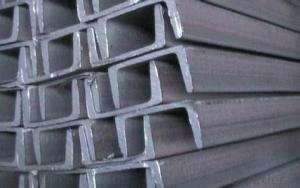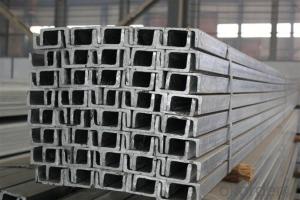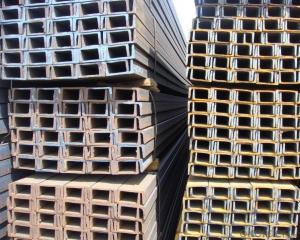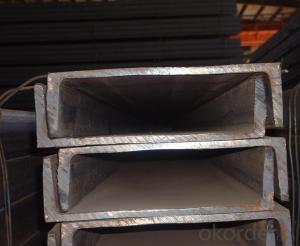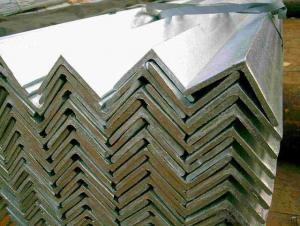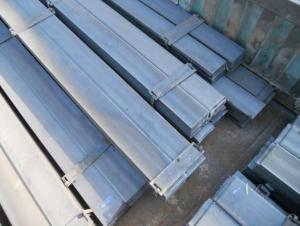Hot Rolled Steel U Channels Q345
- Loading Port:
- Tianjin
- Payment Terms:
- TT OR LC
- Min Order Qty:
- -
- Supply Capability:
- 200000 m.t./month
OKorder Service Pledge
OKorder Financial Service
You Might Also Like
Minimum Order Quantity: 25 Tons Unit: m.t. Loading Port: Xingang Port
Supply Ability: 1000 Tons Per Day Payment Terms: TT or L/C
Product Description:
Specifications of Hot Rolled Steel U Channels Q345:
Standard Applied: GB Standard, EN Standard(UPN), JIS Standard
Sizes: 50mm to 300mm
Material Grade: Q235B, Q345B, S235JR, SS400, ASTM A36
As shown in the figure:
| JIS U CHANNEL | Standard h | Sectional b | Dimension s | t | Mass: Kg/m |
| (mm) | (mm) | (mm) | (mm) | ||
| 50x25 | 50 | 25 | 3.0 | 6.00 | 2.37 |
| 75X40 | 75 | 40 | 3.8 | 7.00 | 5.30 |
| 75X40 | 75 | 40 | 4.0 | 7.00 | 5.60 |
| 75X40 | 75 | 40 | 4.5 | 7.00 | 5.85 |
| 75X40 | 75 | 40 | 5.0 | 7.00 | 6.92 |
| 100X50 | 100 | 50 | 3.8 | 6.00 | 7.30 |
| 100X50 | 100 | 50 | 4.2 | 6.00 | 8.03 |
| 100X50 | 100 | 50 | 4.5 | 7.50 | 8.97 |
| 100X50 | 100 | 50 | 5.0 | 7.50 | 9.36 |
| 125X65 | 125 | 65 | 5.2 | 6.80 | 11.66 |
| 125X65 | 125 | 65 | 5.3 | 6.80 | 12.17 |
| 125X65 | 125 | 65 | 5.5 | 8.00 | 12.91 |
| 125X65 | 125 | 65 | 6.0 | 8.00 | 13.40 |
| 150x75 | 150 | 75 | 5.5 | 7.30 | 14.66 |
| 150x75 | 150 | 75 | 5.7 | 10.00 | 16.71 |
| 150x75 | 150 | 75 | 6.0 | 10.00 | 17.90 |
| 150x75 | 150 | 75 | 6.5 | 10.00 | 18.60 |
Usage/Application of Hot Rolled Steel U Channels Q345:
The steel u channel can be applied to construction of warehouses, workshops, sport stadiums and car parks etc. In details, the steel u channel belongs to carbon structural steel which is applied to in the field of construction and machinery. The steel u channel is usually used for arch-itechtural structure, and they could be welded in order to support or hang a vari-ety of facilities. They are also usually used in combination with I beam. Generally,the steel u channel must possess perfect welding property, riveting property and mechanical property and so on.
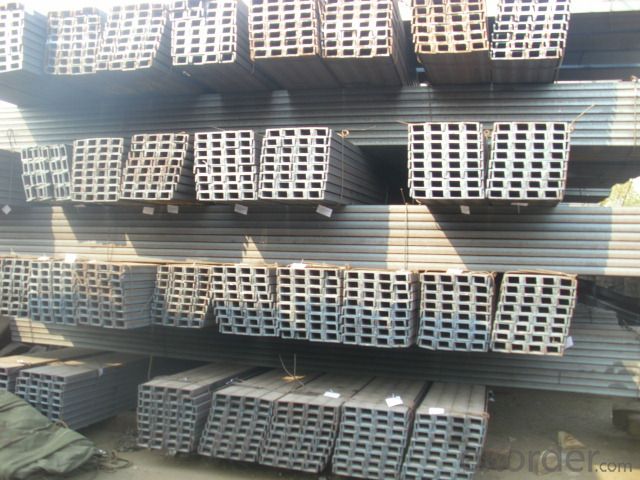
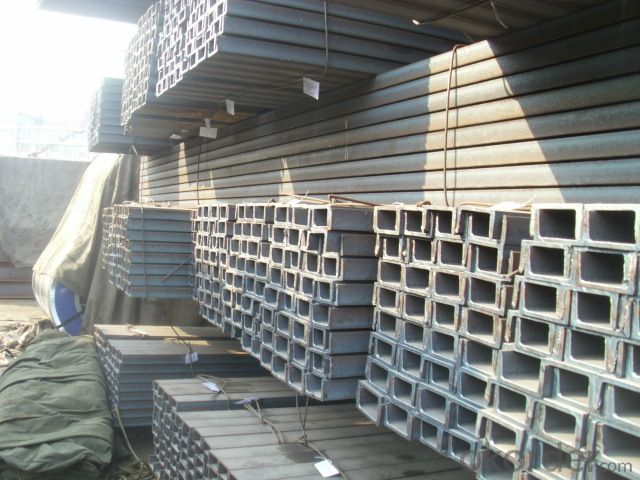
Package & Delivery: Hot Rolled Steel U Channels Q345
The steel u channel will be packed in bundle with steel wire at each end of every bundle and color marking in order to help the customer to recognize his goods more easily at sight.
And steel u channel could be loaded into 20ft or 40ft container, or by bulk cargo. If the weight of each bundle reaches less than 3.5 mt, the loading by break bulk cargo should be choosed. When the weight of each bundle reaches less than 3mt, the loading by container should be choosed.
As for the transportaion from mill to loading port, the truck will be usually used. And the maximum quantity for each truck is 40mt.
All in all, we could do in accordance with customer's request
- Q:Can steel angles be used in mining or quarrying machinery?
- Steel angles are indeed applicable in mining or quarrying machinery. They offer structural support and reinforcement to different machinery components used in these sectors. Frames, supports, and brackets for equipment like crushers, conveyors, and screens are often constructed using steel angles. Due to their high strength and durability, steel angles can withstand the heavy loads, vibrations, and harsh operating conditions commonly experienced in mining or quarrying operations. Moreover, steel angles can be easily fabricated and welded to meet specific design needs, making them a flexible option for machinery applications in these industries.
- Q:How do steel angles perform under cyclic loading?
- Steel angles are widely used in various structural applications due to their excellent strength and stiffness properties. When subjected to cyclic loading, which refers to repeated loading and unloading cycles, steel angles perform exceptionally well. Under cyclic loading, steel angles exhibit a phenomenon known as fatigue, which is the progressive and localized structural damage that occurs when a material is subjected to repeated loading and unloading. However, steel angles have a high fatigue resistance, making them highly suitable for applications where cyclic loading is expected. The key factor contributing to the performance of steel angles under cyclic loading is their material properties. Steel, being a ductile and resilient material, is able to deform and absorb energy under cyclic loading, thereby preventing the accumulation of stress concentrations that could lead to failure. Moreover, steel angles are typically designed with a sufficient factor of safety to withstand cyclic loading without compromising their structural integrity. This ensures that they can endure numerous cycles of loading and unloading without experiencing significant deformation or failure. In addition to their inherent material properties, the structural design and fabrication of steel angles also play a crucial role in their performance under cyclic loading. Proper design, including consideration of the expected loading conditions and appropriate reinforcement, ensures that steel angles can withstand cyclic loading without experiencing excessive deformation or stress concentrations. Overall, steel angles are well-suited for applications involving cyclic loading due to their high fatigue resistance, ductility, and structural design considerations. Their ability to withstand repeated loading and unloading cycles makes them a reliable and durable choice in various structural systems.
- Q:What are the different surface finishes for steel angles?
- Steel angles can be given various surface finishes to meet different aesthetic and functional requirements. Some commonly used finishes for steel angles include: 1. Mill Finish: Obtained straight from the mill without any treatment, this finish has a rough and dull appearance with visible imperfections and mill scale. 2. Hot-dip Galvanized: The steel angle is immersed in molten zinc, creating a protective coating that offers excellent corrosion resistance, ideal for outdoor and marine applications. 3. Powder Coated: A dry powder is applied to the steel angle and then cured with heat, resulting in a durable and smooth finish. This finish provides a wide range of color options and offers good corrosion resistance and aesthetics. 4. Painted: Different types of paint, such as enamel, epoxy, or acrylic, can be used to enhance the appearance of steel angles and provide some level of corrosion protection. 5. Stainless Steel: Steel angles made from stainless steel have a natural corrosion-resistant surface finish. They are commonly available in brushed or polished finishes, giving a clean and shiny appearance. 6. Galvannealed: This specialized finish involves galvanizing the steel angle and then heat treating it to create a matte, grayish finish. Galvannealed finish offers good corrosion resistance and paint adhesion, making it suitable for applications that require both. These are just a few examples of the available surface finishes for steel angles. The choice of finish will depend on factors such as the intended use, environment, and desired appearance of the steel angle.
- Q:What are the common uses of equal steel angles?
- Equal steel angles are a versatile and commonly used structural component in various industries. Some of the common uses of equal steel angles include: 1. Construction: Equal steel angles are frequently used in construction projects, particularly for framing, support, and bracing structures. They are commonly used in the construction of buildings, bridges, and other infrastructure projects. 2. Manufacturing: Equal steel angles are also widely used in manufacturing industries, such as automotive, machinery, and shipbuilding. They are utilized in the fabrication of frames, chassis, supports, and various other structural components. 3. Shelving and Racking: Equal steel angles are often used in the construction of shelving and racking systems. They provide strength and stability to support heavy loads and are commonly used in warehouses, retail stores, and industrial facilities. 4. Fencing and Security: Equal steel angles are commonly used in the construction of fences and gates. They provide a strong and durable framework for securing properties, creating boundaries, and protecting assets. 5. Stairs and Handrails: Equal steel angles are frequently used in the construction of stairs and handrails. They provide support and stability to ensure safe and functional access to different levels in buildings, walkways, and outdoor structures. 6. Infrastructure and Utilities: Equal steel angles are utilized in various infrastructure and utility projects, including electrical transmission towers, telecommunications masts, and solar panel installations. They provide the necessary support and stability for these structures. 7. Agricultural and Farming: Equal steel angles are commonly used in the agricultural and farming industry for constructing fences, gates, and animal enclosures. They provide a durable and secure framework for containing livestock and protecting crops. 8. Decorative and Architectural: Equal steel angles are also used for decorative and architectural purposes. They can be utilized to create unique and aesthetically pleasing designs in buildings, furniture, and other decorative applications. Overall, equal steel angles have numerous applications across different industries due to their strength, versatility, and cost-effectiveness. Whether it is for construction, manufacturing, infrastructure, or decorative purposes, equal steel angles play a vital role in providing structural support and stability.
- Q:How do you calculate the moment of inertia of a steel angle?
- In order to determine the moment of inertia of a steel angle, it is necessary to have knowledge of the angle's dimensions and shape. The moment of inertia is a measurement of an object's resistance to rotational changes and is crucial in the fields of engineering and physics. The moment of inertia, designated as I, can be computed using the following equation: I = (b * h^3) / 12 In this equation: - I represents the moment of inertia - b corresponds to the base width of the steel angle - h denotes the height or leg length of the steel angle This equation assumes that the steel angle is a uniform and solid entity. If the steel angle possesses varying dimensions or contains holes, the calculation becomes more intricate and may necessitate additional formulas or numerical methods. It should be emphasized that the moment of inertia is dependent on the axis of rotation. The aforementioned equation calculates the moment of inertia with respect to the centroidal axis, which is the axis that passes through the angle's center of mass. If the moment of inertia needs to be determined for a different axis, the parallel axis theorem or other advanced techniques may need to be employed. In practical applications, it is often beneficial to consult engineering handbooks or reference materials specifically tailored to steel angles. These resources may offer more comprehensive formulas or tables that consider specific design characteristics and dimensions.
- Q:What are the different methods of surface powder coating for steel angles?
- There are several methods of surface powder coating for steel angles. These methods are used to apply a protective and decorative layer of powder coating onto the steel surface. 1. Electrostatic Spraying: This is one of the most common methods used for powder coating steel angles. It involves using an electrostatic spray gun to apply the powder coating onto the surface. The powder particles are positively charged and are attracted to the grounded steel angle, resulting in a uniform and even coating. 2. Fluidized Bed: In this method, the steel angles are preheated and then dipped into a bed of fluidized powder particles. The heat from the steel causes the powder particles to melt and adhere to the surface, forming a smooth and durable coating. 3. Powder Coating Booth: This method involves placing the steel angles inside a powder coating booth. The booth is equipped with a powder spray gun that applies a fine mist of powder coating onto the surface. The angles are then cured in an oven to melt and bond the powder particles, creating a strong and long-lasting coating. 4. Electrostatic Fluidized Bed: This method combines the benefits of electrostatic spraying and fluidized bed techniques. The steel angles are preheated and then dipped into a bed of fluidized powder particles. An electrostatic charge is also applied to the powder particles, ensuring a more uniform and controlled coating. 5. Tribocharging: In this method, the powder coating is applied to the steel angles by frictional charging. The powder particles are passed through a tribocharging gun, which imparts a positive charge to the particles. The charged particles are then attracted to the grounded steel angle, resulting in a high-quality and consistent coating. Each of these methods has its own advantages and suitability for specific applications. The choice of the coating method depends on factors such as the desired finish, coating thickness, production volume, and cost considerations.
- Q:Can steel angles be used in mezzanine construction?
- Yes, steel angles can be used in mezzanine construction. Steel angles are commonly used as structural elements in construction due to their strength and versatility. In mezzanine construction, steel angles can be used as framing members to support the floor or platform of the mezzanine. They can also be used to create the framework for the stairs or railing systems. Steel angles provide stability and support to the mezzanine structure, making them a popular choice in this type of construction.
- Q:How do you calculate the shear force on a loaded steel angle?
- To calculate the shear force on a loaded steel angle, you need to determine the applied load on the angle and consider the angle's cross-sectional properties. Shear force can be calculated by multiplying the applied load by the appropriate factor of safety, and dividing it by the cross-sectional area of the angle.
- Q:Where can you buy steel angles?
- There are various places where you can purchase steel angles. One possibility is to pay a visit to a local hardware or building supply store. These establishments usually have a wide selection of construction materials, which includes steel angles, that you can buy. Moreover, you can also inquire with metal suppliers or steel fabricators in your vicinity. They typically specialize in the sale of steel products, including angles, and can offer you a variety of choices to select from. Another option is to explore online marketplaces and industrial supply websites. These platforms present a convenient means to browse and purchase steel angles from a range of suppliers, often with the added benefit of being able to compare prices and read customer reviews. Whether you have a preference for shopping in person or online, there are numerous options available to fulfill your specific requirements for purchasing steel angles.
- Q:What are the common corrosion protection methods for steel angles?
- Steel angles can be protected from corrosion in multiple ways. The objective of these methods is to hinder or reduce the corrosion process caused by exposure to moisture or certain chemicals. Here are some widely used techniques for corrosion protection in steel angles: 1. Galvanization: This popular method involves coating the steel angle with a layer of zinc. The zinc acts as a sacrificial anode, corroding instead of the steel when exposed to moisture or chemicals. Galvanization provides excellent corrosion protection, significantly extending the lifespan of steel angles. 2. Painting: A layer of paint can serve as a barrier between the steel angle and its surroundings, preventing moisture and chemicals from reaching the surface. It is crucial to select the appropriate paint type designed specifically for corrosion protection and ensure proper surface preparation before painting. 3. Powder coating: This technique entails applying a dry powder to the steel angle, which is then heated and cured to form a durable and protective coating. Powder coating delivers excellent corrosion resistance and is commonly used in outdoor settings. 4. Epoxy coating: Epoxy coatings are frequently employed in corrosive environments like chemical plants or marine applications. These coatings exhibit high chemical resistance and create a protective barrier against corrosion. 5. Cathodic protection: This method involves utilizing the steel angle as the cathode in a galvanic cell, with a sacrificial anode connected to it. This arrangement initiates an electrochemical reaction that prevents corrosion. Cathodic protection finds application in structures such as underground pipelines or offshore platforms. It is essential to consider various factors such as the specific environment, expected service life, and budget while selecting a corrosion protection method. Seeking advice from corrosion protection specialists or engineers can assist in determining the most suitable approach for a particular application.
1. Manufacturer Overview |
|
|---|---|
| Location | |
| Year Established | |
| Annual Output Value | |
| Main Markets | |
| Company Certifications | |
2. Manufacturer Certificates |
|
|---|---|
| a) Certification Name | |
| Range | |
| Reference | |
| Validity Period | |
3. Manufacturer Capability |
|
|---|---|
| a)Trade Capacity | |
| Nearest Port | |
| Export Percentage | |
| No.of Employees in Trade Department | |
| Language Spoken: | |
| b)Factory Information | |
| Factory Size: | |
| No. of Production Lines | |
| Contract Manufacturing | |
| Product Price Range | |
Send your message to us
Hot Rolled Steel U Channels Q345
- Loading Port:
- Tianjin
- Payment Terms:
- TT OR LC
- Min Order Qty:
- -
- Supply Capability:
- 200000 m.t./month
OKorder Service Pledge
OKorder Financial Service
Similar products
New products
Hot products
Hot Searches
Related keywords
